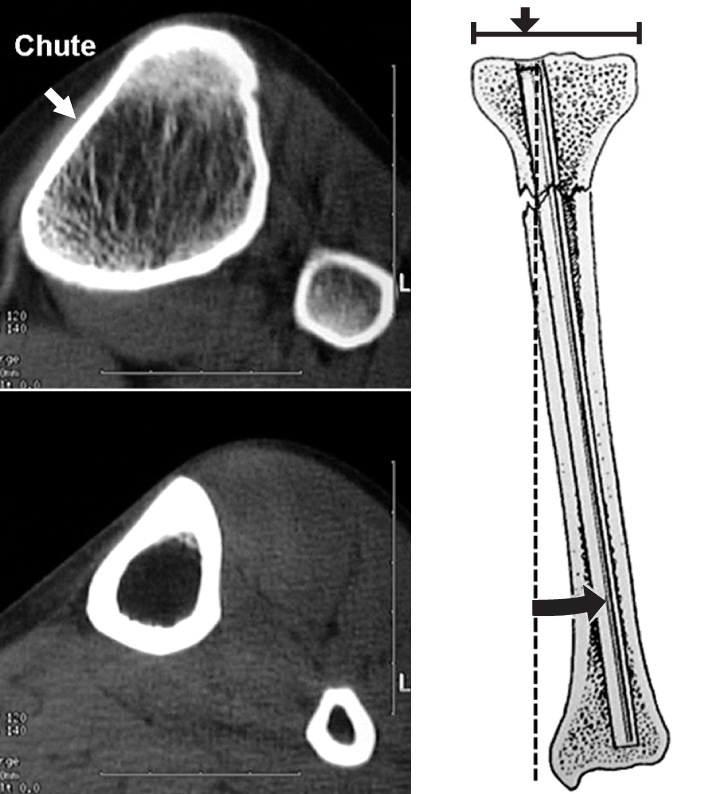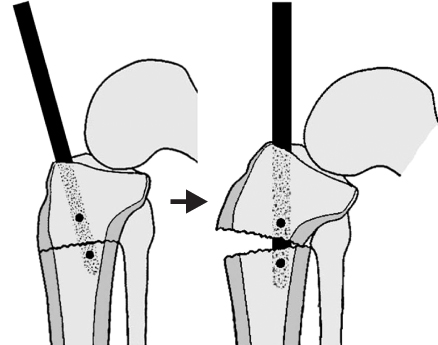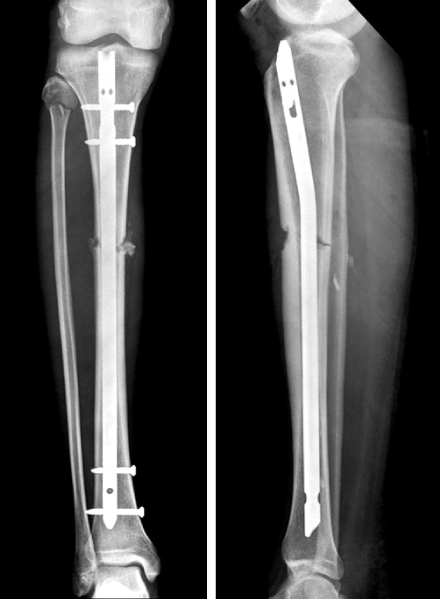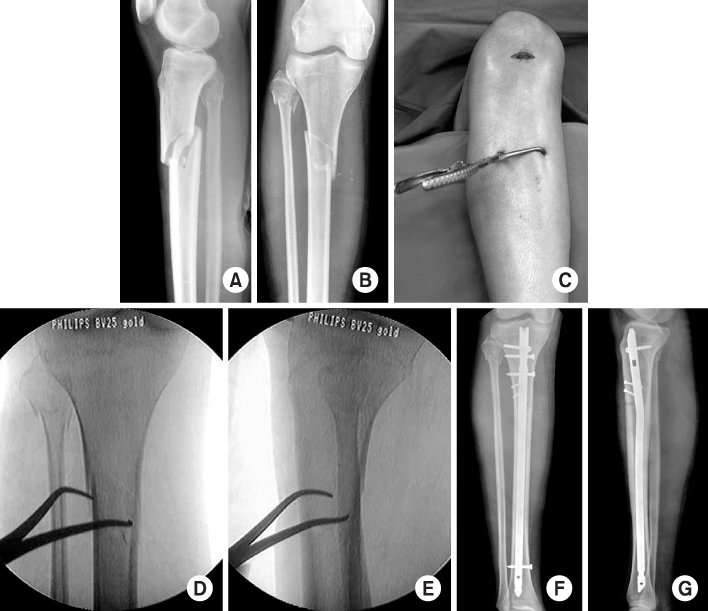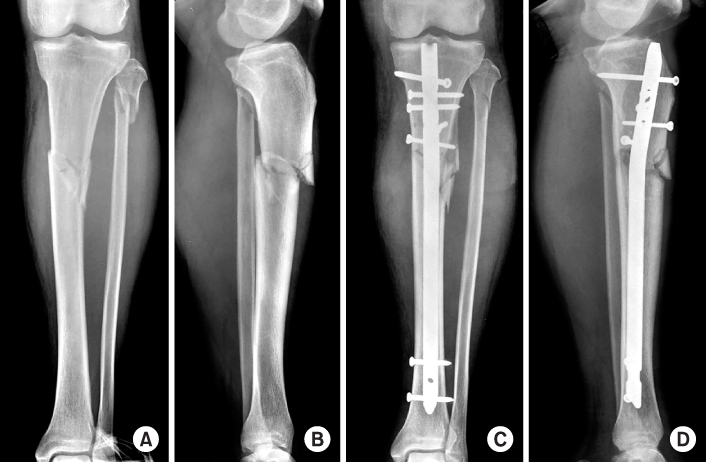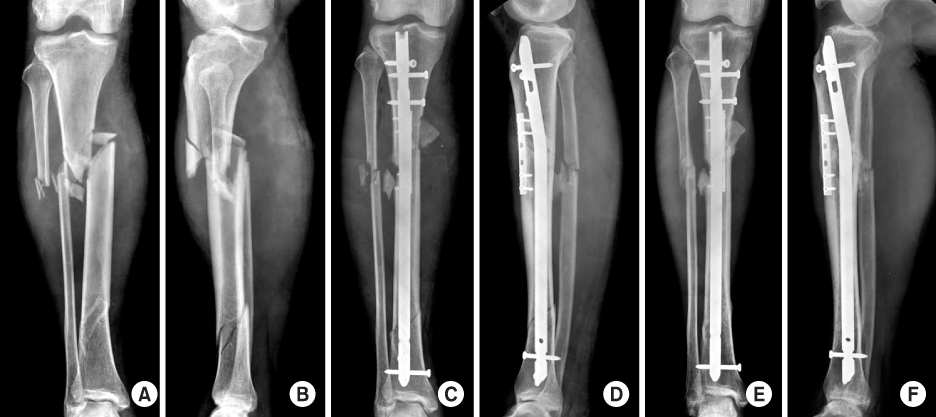J Korean Fract Soc.
2009 Jul;22(3):197-205. 10.12671/jkfs.2009.22.3.197.
Intramedullary Nailing of Proximal Tibial Fractures
- KMID: 2063911
- DOI: http://doi.org/10.12671/jkfs.2009.22.3.197
Abstract
- No abstract available.
MeSH Terms
Figure
Cited by 2 articles
-
Management of Open Fracture
Gu-Hee Jung
J Korean Fract Soc. 2010;23(2):236-250. doi: 10.12671/jkfs.2010.23.2.236.Clinical Outcomes of the Tibia Segmental Fractures Treated by Intramedullary Nail Using Various Reduction Techniques
Oog-Jin Shon, Ji-Hoon Shin, Chul-Wung Ha
J Korean Fract Soc. 2013;26(1):50-55. doi: 10.12671/jkfs.2013.26.1.50.
Reference
-
1. Benirschke SK, Henley MB, Ott JW. Proximal onethird tibial fracture solution. Orthop Trans. 1994; 18:1055–1056.2. Bolhofner BR. Indirect reduction and composite fixation of extraarticular proximal tibial fractures. Clin Orthop Relat Res. 1995; 315:75–83.
Article3. Bono CM, Levine RG, Rao JP, Bebrens FF. Nonarticular proximal tibia fractures: treatment options and decision making. J Am Acad Orthop Surg. 2001; 9:176–186.
Article4. Buehler KC, Green J, Woll TS, Duwelius PJ. A technique for intramedullary nailing of proximal third tibia fractures. J Orthop Trauma. 1997; 11:218–223.
Article5. Cannada LK, Anglen JO, Archdeacon MT, Herscovici D Jr, Ostrum RF. Avoiding complications in the care of fractures of the tibia. Instr Course Lect. 2009; 58:27–36.6. Freedman EL, Johnson EE. Radiographic analysis of tibial fracture malalignment following intramedullary nailing. Clin Orthop. 1995; 315:25–33.
Article7. Gerber A, Ganz R. Combined internal and external osteosynthesis. A biological approach to the treatment of complex fractures of the proximal tibia. Injury. 1998; 29:Suppl 3. C22–C28.
Article8. Gosling T, Schandelmaier P, Muller M, Hankemeier S, Wagner M, Krettek C. Single lateral locked screw plating of bicondylar tibial plateau fractures. Clin Orthop Relat Res. 2005; 439:207–214.
Article9. Henley MB, Meier M, Tencer AF. Influences of some design parameters on the biomechanics of the undreamed nail. J Orthop Trauma. 1993; 7:311–319.
Article10. Hicks CA, Noble P, Tullos H. The anatomy of the tibial intramedullary canal. Clin Orthop Relat Res. 1995; 321:111–116.
Article11. Hutson JJ Jr, Zych GA. Infections in periarticular fractures of the lower extremity treated with tensioned wire hybrid fixators. J Orthop Trauma. 1998; 12:214–218.
Article12. Keating JF, Kuo RS, Court-Brown CM. Bifocal fractures of the tibia and fibula. Incidence, classification and treatment. J Bone Joint Surg Br. 1994; 76:395–400.
Article13. Kim JW, Oh CW, JK Oh, et al. Staged minimally invasive plate osteosynthesis of proximal tibial fracture. J Korean Fract Soc. 2009; 22:6–12.
Article14. Krettek C, Gerich T, Miclau T. A minimally invasive medial approach for proximal tibial fractures. Injury. 2001; 32:Suppl 1. SA4–SA13.
Article15. Krettek C, Miclau T, Schandelmaier P, Stephan C, Möhlmann U, Tscherne H. The mechanical effect of blocking screws ("Poller screws") in stabilizing tibia fractures with short proximal or distal fragments after insertion of small-diameter intramedullary nails. J Orthop Trauma. 1999; 13:550–553.
Article16. Krettek C, Stephan C, Schandelmaier P, Richter M, Pape HC, Miclau T. The use of Poller screws as blocking screws in stabilizing tibial fractures treated with small diameter intramedullary nails. J Bone Joint Surg Br. 1999; 81:963–968.17. Laflamme GY, Heimlich D, Stephen D, Kreder HJ, Whyne CM. Proximal tibial fracture stability with intramedullary nail fixation using oblique interlocking screws. J Orthop Trauma. 2003; 17:496–502.
Article18. Lang JG, Cohen BE, Bosse MJ, Kellam JF. Proximal third tibial shaft fractures. Should they be nailed? Clin Orthop. 1995; 315:64–74.19. Mueller CA, Eingartner C, Schreitmueller E, et al. Primary stability of various forms of osteosynthesis in the treatment of fractures of the proximal tibia. J Bone Joint Surg Br. 2005; 87:426–432.
Article20. Müller ME, Allgöwer M, Schneider R, Willenegger H. Manual of internal fixation. 3rd ed. Berlin, Germany: Springer-Verlag;1992. p. 291–365.21. Nicoll EA. Fractures of the tibial shaft. A survey of 705 cases. J Bone Joint Surg Br. 1964; 46:373–387.22. Nork SE, Barei DP, Schildhauer TA, et al. Intramedullary nailing of proximal quarter tibial fractures. J Orthop Trauma. 2006; 20:523–528.
Article23. Phisitkul P, Mckinley TO, Nepola JV, Marsh JL. Complications of locking plate fixation in complex proximal tibia injuries. J Orthop Trauma. 2007; 21:83–91.
Article24. Ricci WM, O'Boyle M, Borrelli J, Bellabarba C, Sanders R. Fractures of the proximal third of the tibial shaft treated with intramedullary nails and blocking screws. J Orthop Trauma. 2001; 15:264–270.
Article25. Safran O, Liebergall M, Segal D, Mosheiff R. Proximal tibial fractures - should we nail them? Am J Orthop. 2001; 30:681–684.26. Sarmiento A, Gersten LM, Sobol PA, Shankwiler JA, Vangsness CT. Tibial fractures treated with functional braces. J Bone Joint Surg Br. 1989; 71:602–609.27. Tornetta P 3rd. Technical considerations in the surgical management of tibial fractures. Instr Course Lect. 1997; 46:271–280.28. Tornetta P 3rd, Collins E. Semiextended position of intramedullary nailing of the proximal tibia. Clin Orthop. 1996; 328:185–189.
- Full Text Links
- Actions
-
Cited
- CITED
-
- Close
- Share
- Similar articles
-
- Malailgnment Following Intramedullary Nailing of Tibial Shaft Fracture - s comparison between medial parapatellar approachand patellar tendon spltting approach -
- The Clinical Results of Unreamed Interlocking Intramedullary Nailing for Tibial Fractures
- Treatment of Distal Tibial Fractures by Interlocking Intramedullary Nailing
- Malalignment of Tibial Fracture Following Interlocking Intramedullary Nailing
- Reamed versus Unreamed Intramedullary Nailing after External Fixator Application in the Treatment of Open Tibial-Shaft Fracture


